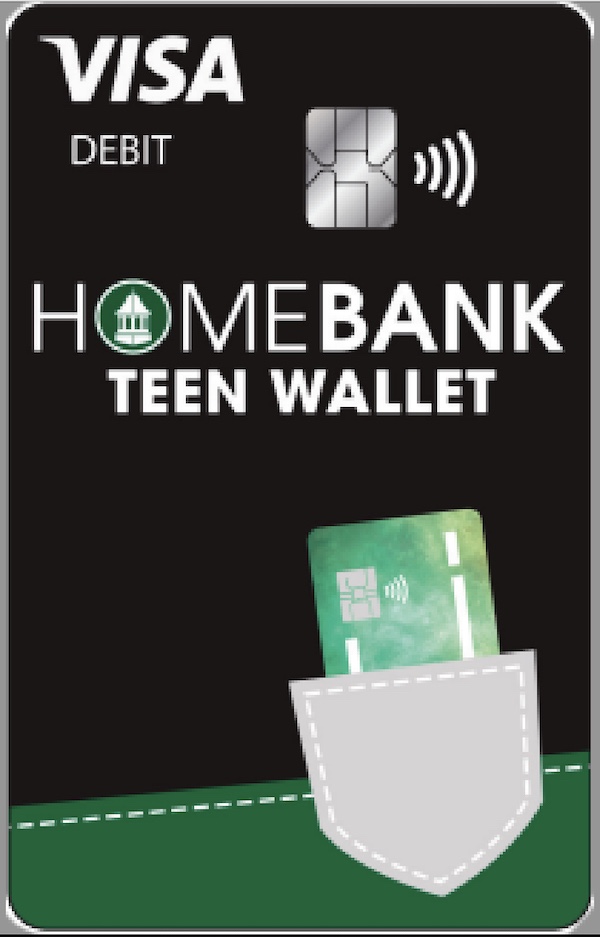New local bank program provides convenience to parents, teaches financial responsibility to children

QUINCY — At a time when Americans have $17.8 trillion in household debt, it’s crucial to have a solid understanding of personal finances. It is perhaps even more important for the next generation of consumers to have the skills to navigate such fickle financial conditions.
A new program at a local bank seeks to do just that.
“As an adult, you think (about) loans because you want a home and things like that,” said Sarah Lung, vice president of retail operations at Homebank in Quincy. “But our kids have financial needs too.”
Catered to children in the 10- to 15-year age range, Homebank’s Teen Wallet program aims to educate young people about financial responsibility and provide parents with a convenient alternative to dishing out cash to their kids when they need spending money.
Banking programs for kids
Shortly after Drew Hilbing, 13, started seeing her friends with their debit cards during the summer, she asked her mom, Bridget Hilbing, for one of her own. Drew was invited to go on vacation with a friend, so the convenience of providing Drew with a week’s worth of spending money on a debit card was far more appealing to Bridget than sending her with a wad of cash that could easily be misplaced.
Drew’s friends had debit cards from Greenlight, a banking platform that provides kids with a debit card and a parent-friendly app to manage their funds. The service is subscription-based, with plans starting at $6 per month — which Bridget wasn’t a fan of. She opted for Homebank instead, stating its locality as an additional perk.
“If there is an issue or we need something, I want to be able to just call somebody who I feel like we know, or we can go in and see somebody,” Bridget said.
Homebank’s program, launched in July, provides a debit card and a checking account to bankers between the ages of 10 and 15. A parent or guardian is needed on the account.
Teen Wallet has no signup or monthly subscription fees. Homebank’s app allows the parents to monitor when and where their child is making purchases, turn their debit card on and off, deposit funds and set up alerts for low balances or excessive spending (though the latter would be difficult to achieve with a default spending limit of $50 per day). Parents can increase the daily limit for larger purchases — a feature that expires after 30 minutes.
“It’s parent-managed, but the kid has the option to look at those things,” Lung said.
Kids are taught what to do if they lose their debit card, how to monitor their account for irregular transactions, the basics of fraud and how to keep their financial information secure in real life and online — and the consequences of failing to do so.
Lung uses the program with her 13-year-old son. She appreciates the convenience of the card and the parental controls, as well as the lessons on financial responsibility her son has picked up on.
“He sees the numbers going down as he’s spending money and he’s like, ‘Oh, I didn’t think I really needed that.’ Learning that is so cool for them to realize on their own instead of us just saying, ‘You don’t need that,’” Lung said. “They don’t understand why they don’t need it.”
Financial literacy in the United States
Drew said she learned basic money management, how to write checks and “a little bit on budgeting” in a Junior Achievement class — a requirement for all sixth-grade students at her parochial school — she’d taken a couple of years prior. Asked if she remembered much from the course, she said, “Not really.”
Illinois public high school students are required to learn the fundamentals of consumer education, including “the basic concepts of financial literacy” and “the roles of consumers interacting with” government and various industries, per Illinois code. This often manifests as a one-time, semester-long course. The lack of a standalone personal finance class requirement earned the state a “B” grade from The Nation’s Report Card on Financial Literacy. (Missouri was given an “A.”)
The American Public Education Foundation, publisher of the report card, describes symptoms of financial illiteracy as “accumulating oppressive debt, misusing and abusing credit cards and inadequate or non-existent savings,” resulting in “increased bankruptcy filings, overdependence on government and no retirement savings.”
The most recent Quarterly Report on Household Debt and Credit released earlier this month shows a staggering $17.80 trillion in household debt, and $12.90 trillion can be attributed to housing debt. Auto loans account for the largest share of non-housing debt ($1.63 trillion), closely followed by student loans ($1.59 trillion) and credit card debt ($1.14 trillion).
The “symptoms” of poorly managed personal finances are all too familiar for most Americans, even when most states score decently in education requirements surrounding financial literacy.
The good news is that Illinois ranks among the lowest states in debt-to-income ratios, according to the Federal Reserve System. Better yet, Adams County is tied with a handful of other counties for the lowest debt-to-income ratios in the state.
It’s possible that an earlier introduction of financial literacy facilitated by a more hands-on approach could yield more fruitful personal financial conditions for future consumers.
‘There has to be some responsibility’
It’s unlikely that Drew will be contemplating ambiguous financial terms and concepts like “amortization” or “compound interest” while on the way to Washington, D.C., for a class trip this fall. It’s much more likely, however, that she will make several small decisions on what’s worth spending her money on and what isn’t.
Drew’s new debit card will provide a sense of financial freedom and an opportunity to practice money management when she heads to D.C. Upon checking her daughter’s spending history in the Homebank app, Bridget can rest easy knowing that every dollar she sent with Drew wasn’t left behind on a museum bench, carried away into the wind or spent exclusively on Starbucks.
“It’s not a free-for-all of ‘buy what you want whenever you want,’” Bridget said. “There has to be some responsibility.”
More information on Homebank’s Teen Wallet can be found on the bank’s website.
Miss Clipping Out Stories to Save for Later?
Click the Purchase Story button below to order a print of this story. We will print it for you on matte photo paper to keep forever.

